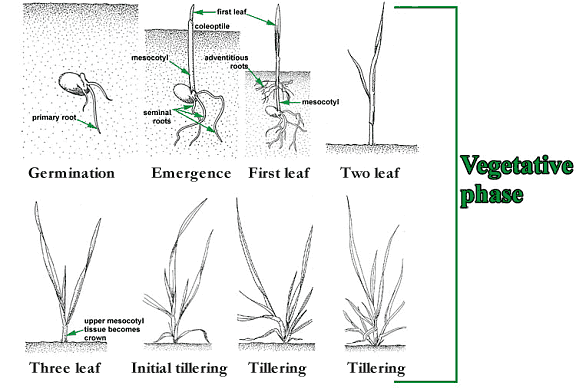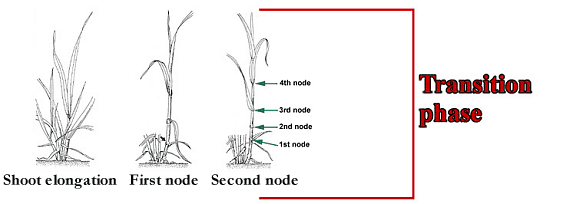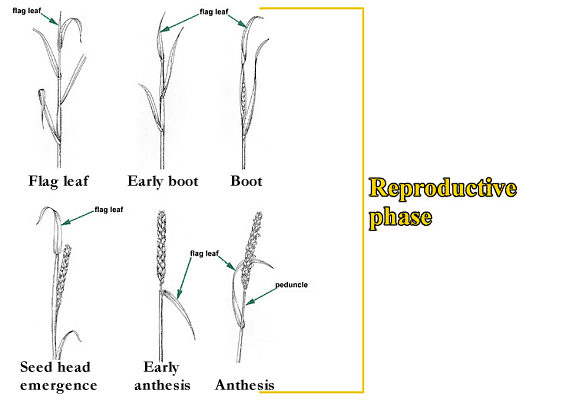Grasses are defined as herbaceous, monocotyledons with jointed, flowering culms. Some texts further classify grasses as being jointed or nonjointed with respect to how they regrow. Grasses that produce jointed culms again in regrowth are called jointed grasses. Grasses that regrow without elevating a flowering culm are called nonjointed.
Understanding this distinction in regrowth habit is important in developing successful management practices because jointed grasses are more easily damaged. They elevate their apical meristems several times in a year. Damage occurs from untimely removal of the apical meristem. Defoliation is untimely when regrowth mechanisms are immature. Some grass seed mixtures contain one or more of each type (jointed and nonjointed) making management of such mixtures complicated.
The flowering stems of all grasses pass through a gradient of developmental phases commencing with vegetative shoots and ending with seed production (see "Grass Development Phases" section for a description of growth stages).



During vegetative growth leaves are pushed upward but after becoming induced to flower, the shoot produces a central stem called a culm. The culm consists of nodes separated by internodes. Each node with its associated internode represents a stem segment, commonly called a joint.
Thus, the term "jointing" refers to the commencement of internode elongation, a process which creates a main stem (culm) and also elevates the meristematic growing point to a vulnerable defolitation height. Destruction (decapitation) of this elevated meristem forces regrowth from adventitious buds in crown tissue. Early decapitation results in delayed regrowth because buds are immature.
Although this is a highly critical management issue, it is only practically important for grasses that have a high proportion of floral tillers. Some grasses produce many non-flowering (sterile) tillers which remain culmless and the apical meristem remains low.
Phrased differently, with proper environmental conditions, many grass species are prolific seed producers. A high percentage of the shoots will contain a jointed culm which will support a seedhead in the first cycle. In contrast, other grass species are less prolific and produce many non-flowering, culmless, vegetative shoots even though environmental conditions would support floral induction. Various species have different seed production capacities.
Grasses with many flowering shoots should be carefully managed during the early-jointing stage of development. Early-jointing implies that the internodes of the developing culm have commenced elongation thereby raising the meristematic tissue to a vulnerable height. If the grass is producing mainly flowering shoots and they are removed then there is not a good regrowth mechanism.
In less-prolific species, those with fewer flowering culms but more vegetative (sterile) shoots, the vegetative shoots provide for rapid competitive regrowth even when early-spring growth is mowed low or intensively grazed during the early-jointing stage of culm development. This is why grasses like Kentucky bluegrass and bentgrasses are good candidates for turf, landscaping, and intensive grazing. Rapid recovery after mowing is due to well-established vegetative shoots that did not commence elongation and therefore have a growing point nestled low in the shoot. Without thoughtful management, this type of grass has a decidedly competitive advantage which can be good or bad depending on the purpose and goals of the manager.
Though these grasses may tolerate intensive grazing because their apical meristems are low in the many vegetative (sterile) tillers, there is a risk for poor management in dry conditions or after long rest intervals. Dry conditions and long rests may cause intercalary meristems (at the base of the leaf blade) to become elevated and vulnerable. This elevation means that defoliation may be removing the leaf bases. Once that meristem is removed a leaf cannot be regenerated there. Excessive leaf blade removal disrupts photosynthesis and transpiration which leads to a thinning of the stand and the opportunity for invasion by undesired species.
If very intensive defoliation destroys the apical and intercalary meristems, no subsequent growth from that tissue is possible. Regrowth eventually can occur from new shoots arising from basal buds in the crown zone. If those buds are not yet well developed, recovery is delayed and companion species and weeds may flourish during the delay. To reduce this threat, avoid shoot decapitation until basal buds have produced new shoot sprouts which will produce a second growth (aftermath) for mid-summer production.
There are grass species that produce many flowering shoots, while others produce some flowering shoots and many vegetative shoots. There are also those that have shoots that produce a culm but fail to become induced to flower. This results in a vegetative shoot with an elevated meristem. Such shoots are intolerant of defoliation because the growing point is raised and, if adventitious buds in crown tissue are not developed sufficiently to serve as a regrowth mechanism, regrowth is greatly delayed.
Jointed Grass Examples are: smooth bromegrass, wheatgrasses, quackgrass, timothy, reed canarygrass, and annual ryegrass. Culmed (jointed) vegetative shoots, whether found in the initial spring growth or in the aftermath, develop chiefly (if not entirely) in grasses which produce new tillers extravaginally, via basal crown buds, rhizomes or stolons.
In sharp contrast, intravaginal tillers, characteristic of bunch grasses, produce a jointed culm only if they become induced to flower. With some exceptions, floral induction of aftermath shoots of intravaginal types is rare due to improper climatic conditions. The shoot primordium (growing point containing the apical and intercalary meristems) of such shoots remains at or near the soil surface. This feature provides a degree of grazing tolerance, however, with deferment of defoliation, mid-summer hay harvesting, sheath elongation becomes a factor groverning recovery. If most of the leaf blades are severed beneath the collar (through the sheath) there will be no blade renewal and the grass may suffer.
Aftermath is a term assigned to the recovery growth following the removal of grass seedheads. It is known that the initiation and early development of aftermath shoots is temporarily suppressed by hormones associated with floral development. The suppression is called "apical dominance" because the apical meristem is dominating the growth processes by producing seed. With cool-season grasses that are prolific seed producers, destruction of seedheads by intensive grazing or clipping at the "boot stage" of development is wise because it disrupts apical dominance, allowing growth energy to be redirected to aftermath growth from buds at the plant base.
The practice of removing seedheads during the boot stage is particularly helpful with grasses such as orchardgrass and smooth bromegrass because the aftermath shoots of these grasses are not nourished by the mother root system. To enhance midsummer production, aftermath shoots must regenerate roots before the advent of hot arid conditions of midsummer. So, preventing any delay is wise. Dry weather limits root growth which limits shoot growth.
Aftermath shoots of grasses such as timothy, bromegrass, reed canarygrass, and quackgrass produce culms. Culm development commences approximately 4-6 weeks after initial recovery growth. Intensive defoliation at this time is ill-advised because the shoot growing point may be destroyed at a time when basal buds are not yet ready to produce new shoots. Summer dormancy or death may be the result of this mismanagement.
Grasses pass progressively through the developmental phases (vegetative, transition, reproductive), but regrowth after seedheads have been removed can happen in two ways: 1) regrowth can progress through the same phases as intial growth (culmed aftermath), or 2) regrowth can remain vegetative, that is, growth without elongation and preparation for reproduction (culmless aftermath).
Most species do not produce seedheads in aftermath shoots (they have culmless aftermath). Certain species do produce a culm that remains vegetative, producing an indeterminant number of leaves. Research has not determined a complete listing of species with this growth habit but smooth bromegrass, timothy, reed canarygrass, and quackgrass are examples of such growth. They are sometimes called jointed grasses but ""culmed aftermath grass species"" is a more accurate term. This type of growth habit will influence midsummer growth and stand persistence unless management considers the location of the growing point when the shoots develop a culm.
Given adequate moisture and fertility, culm development commences after approximately 5 weeks of recovery. Thus, with 3-4 weeks of regrowth, the growing point is below the normal grazing height. After 5-6 weeks recovery, close examination reveals that culm development has commenced. Basal internode elongation has elevated the meristematic growing point to a vulnerable height. In this situation intensive defoliation may cause nearly complete loss of stands in sensitive species, particularly if basal buds have not yet intitiated new tillers necessary for regrowth.
Determining whether a grass species is culmed or culmless in growth after initial growth is important in defoliation management. This is because the growing point of the culm could be elevated and removed. But consider another potential problem. If the rest interval between defoliations is too long and growth from the leaf sheaths progresses too far, then the meristematic tissue of the leaf blade in the collar region is raised to a vulnerable height. If the leaf blade is severed beneath the meristematic zone of the collar there can be no more leaf generation of that leaf. If a leaf blade is severed above the collar area, the leaf blade can continue to grow. If several leaves on a shoot are severed below the collar regions then photosynthesis is greatly hampered since it takes place in the blades. Transpiration is also reduced, reducing water movement upward from the root zone. This could lead to reduced photosynthesis, cell division, and cell expansion in the apical meristem which leads to death of the shoot. This is termed "scalping" by turf managers.
Scalping of turf species has much in common with the overgrazing of culmless aftermath shoots in grasses like big bluestem, little bluestem, and Indiangrass. These species are often classified as "decreasers" under heavy grazing. These species will often decrease under grazing allowing grama grasses and buffalograss to prevail. These two have a lesser tendency to produce elongated leaf sheaths, and the growing points of shoots remain low. This describes how overgrazed tall-grass prairies became short-grass prairies.
An early bite can be taken successfully on pastures if the manager knows the phase of development of the grasses. It is important to preserve critical meristems for regrowth purposes. Grasses become somewhat more tolerant of intensive grazing once the flowering shoots have started culm development (midjointing stage). Utilize the grass before the seedheads emerge from the shoot.
Scenario: Effects of mowing a mixed stand of bromegrass and timothy when bromegrass is in the early-transition stage and timothy is as yet in the vegetative stage.
Expected results: Bromegrass will be "decapitated" because internode elongation has elevated the meristematic zone of the culm (growing point) to a vulnerable height. Recovery will be via new shoots arising from basal buds in crown tissue. In contrast, timothy shoots will continue development because the growing point was nested deep in the base of the shoot. This mowing would favor timothy.
In contrast to the above demonstration, the grass mixture could be mowed when the bromegrass had reached the late-boot to early-heading stage, when timothy was in the early transition stage. The expected results? The timothy would have been "decapitated" in an untimely manner. Removal of the shoot primordium at ""early transition"" suppresses timothy because basal sprouts are not yet capable of producing prompt, competitive growth.
Also see Sod Contamination in the Management Scenarios section of this project.